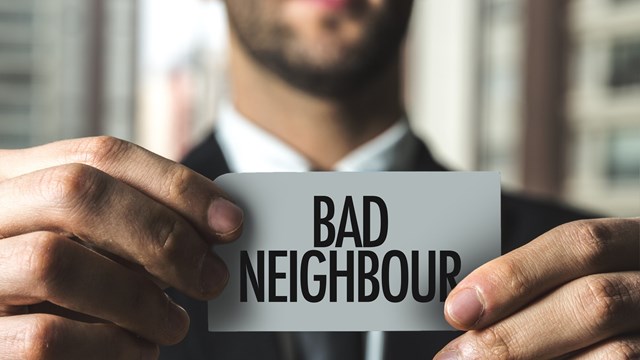
Living in a multifamily dwelling requires tolerance for other people, particularly when those people are noisy, smelly, or have questionable taste in door decorations. In New York, where the majority of people share a wall with at least one other household, tolerance gets tested on multiple fronts. When one person’s floor is another person’s ceiling, residents are constantly reminded of how close they actually are to their neighbors.
And proximity does not always mean congeniality. While many shareholders and unit owners can easily address their concerns with an offending neighbor, and that neighbor will readily make adjustments to accommodate those concerns, sometimes a situation simply requires the involvement of a third party.
Peaceful Enjoyment
In the case of co-ops, condos, and homeowners’ associations, the property’s managing agent is the party typically tasked with listening to both sides of the conflict, assessing the veracity and severity of the claims, and offering suggestions for resolution. “It is an agent’s responsibility to make every attempt to amicably resolve disputes,” says Georgia Lombardo-Barton, President of Barton Management in Manhattan. “Whether it’s a co-op or condo, each apartment resident is entitled to proper and peaceful enjoyment of their apartment. All situations that violate that right must be abated immediately.”
The approach to conflict resolution that Lombardo-Barton uses starts with an investigation of the complaint. Sometimes a resident complains about an odor or noise from an unknown source, or attributes the nuisance to the wrong unit. Neighbors are consulted and details sorted out. Depending on the nature, frequency, and time of day of the disturbance, determining its source and whether it violates the building’s proprietary lease can be a weeks-long affair.
As soon as the source is identified, Lombardo-Barton’s agents meet with the owner of the offending unit to address the complaint. (It’s the actual owner of the unit who’s ultimately responsible for any resolution, even if the source of the problem is a tenant or subletter occupying the unit.) Careful and cooperative communication is key to an expedient, amicable resolution. Following that conversation, if it seems necessary, Lombardo-Barton will invite the affected party to discuss the matter jointly. She finds that these steps lead to successful resolution most of the time.
When Talking Fails
But then there are those other times where a dispute can’t be resolved by conversation alone. Scott Soifer, a managing agent with Charles H. Greenthal & Co. who manages buildings in Manhattan and Queens, recounts two situations where disputes between neighbors escalated to the point where he had to involve a professional mediator. The issue in dispute? Noise. In both instances, Soifer and his superintendent inspected the apartments and performed what he calls “unscientific noise tests.” Aside from normal footsteps and “the usual apartment noise,” Soifer says they detected “nothing that is beyond noise code.” Additionally, both offending apartments were compliant with required floor coverings in their units. “But there was no resolution,” recalls Soifer. “So once I’d exhausted my letter-writing and the issue was still not resolved and [the neighbor] was still complaining, I referred it to Community Mediation Services.”
Offered by the Queens Courthouses, Community Mediation Services is a program designed to address these very types of hard-to-resolve disputes. According to Soifer, “About 50 percent of their mediation is [for] noise complaints.” Once the parties involved in the dispute agree to meet, they have the opportunity to address the issue at a neutral location with the assistance of a professional mediator. In Soifer’s examples, however, mediation was not the ultimate resolution. “[One of the disputes] festered on for a long time, to the point where I had to tell the folks on the bottom apartment that they just had to understand that the person above [them] was carpet compliant; he provided his work schedule; he was fully honest with [them]. ... I tried mediation with them both, but there's nothing more I could do. They just had to learn to be tolerant.” In the second situation, the other offending resident eventually moved away.
Making a Stink
One area of complaint that is harder for managers to resolve is odors. “Cooking odors is a big one,” says Soifer. “You have open ventilation systems that go up through the roof fans, and so some of those odors can find their way into people’s apartments up the line.” In multicultural buildings like the ones Soifer manages, some residents’ delicacies are another’s offensive smell. “There are various measures that people can take to mitigate [such odors],” says Soifer. If their kitchen has a window, he advises residents to point a fan out the window to exhaust the smell out of their apartment entirely.
Cigarettes and other smoking devices pose an even greater challenge, since they are very difficult to investigate and resolve, and also pose potential harm to neighbors’ health and comfort. Even in one of her Upper East Side buildings that was one of the first in the city to go smoke-free, Lombardo-Barton says, “We had received consistent complaints of cigarette smoke smells from a unit owner on a lower floor. The complaint alleged that the smells were more prevalent at night and early morning during the weekdays. This complaint was ongoing for over a year. Because of the time of day the smell was detected, neither the super nor anyone from management was available to confirm the smell. The staff was not able to detect cigarette smells from behind any of the apartment doors on the floors below.”
Unable to find the source of the offense, Lombardo-Barton installed a bypass and exhaust fan in the ventilation system that diverted smells from the lower floors without restricting airflow -- and that put an end to the problem, and the complaints. But, she says, when an offending tenant is identified, “If the situation persists after several attempts to abate the issue, legal intervention may be necessary.”









2 Comments
Leave a Comment